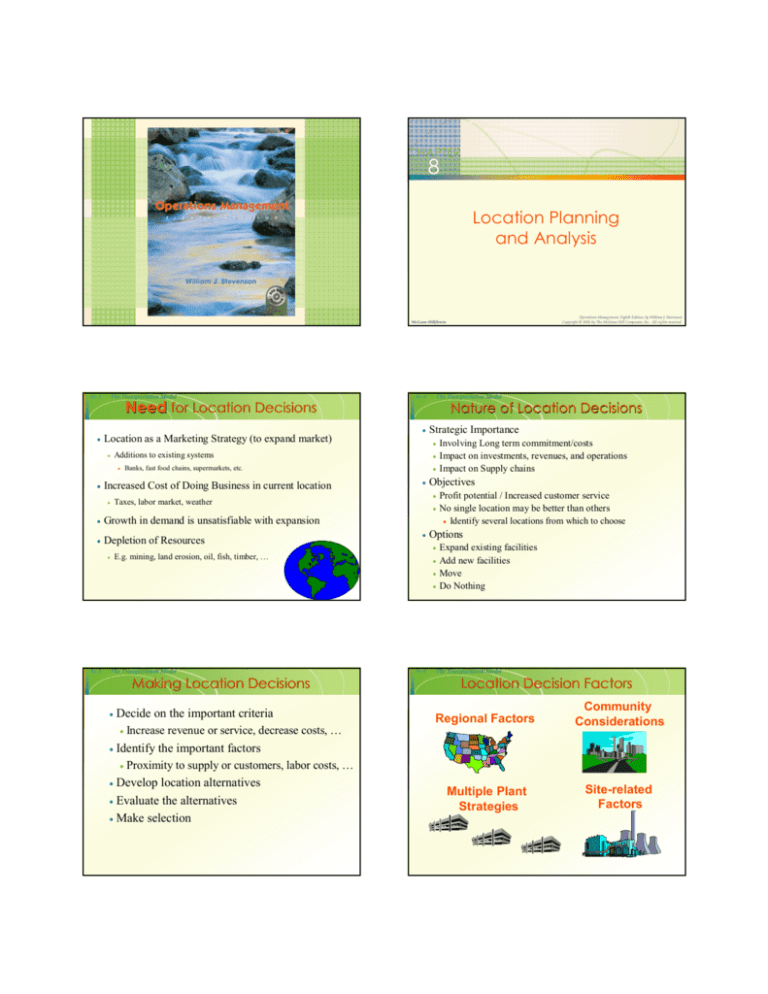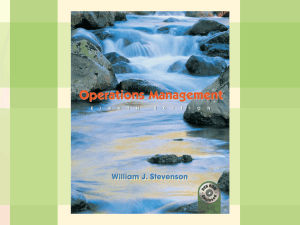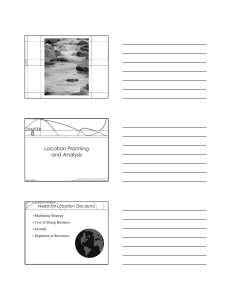
8s-1
The Transportation Model
8s-2
The Transportation Model
CHAPTER
8
Operations Management
Location Planning
and Analysis
William J. Stevenson
8th edition
Operations Management, Eighth Edition, by William J. Stevenson
Copyright © 2005 by The McGraw-Hill Companies, Inc. All rights reserved.
McGraw-Hill/Irwin
8s-3
•
The Transportation Model
Need for Location Decisions
Location as a Marketing Strategy (to expand market)
•
•
•
Growth in demand is unsatisfiable with expansion
•
Depletion of Resources
•
•
•
•
•
The Transportation Model
Making Location Decisions
•
Decide on the important criteria
• Increase revenue or service, decrease costs, …
• Identify the important factors
• Proximity to supply or customers, labor costs, …
• Develop location alternatives
• Evaluate the alternatives
• Make selection
8s-6
Profit potential / Increased customer service
No single location may be better than others
• Identify several locations from which to choose
Options
•
8s-5
Involving Long term commitment/costs
Impact on investments, revenues, and operations
Impact on Supply chains
Objectives
•
E.g. mining, land erosion, oil, fish, timber, …
•
Strategic Importance
•
•
Taxes, labor market, weather
•
Nature of Location Decisions
•
Banks, fast food chains, supermarkets, etc.
Increased Cost of Doing Business in current location
The Transportation Model
•
Additions to existing systems
•
•
8s-4
Expand existing facilities
Add new facilities
Move
Do Nothing
The Transportation Model
Location Decision Factors
Regional Factors
Community
Considerations
Multiple Plant
Strategies
Site-related
Factors
8s-7
The Transportation Model
Regional Factors
8s-8
Quality of life
Services
• Attitudes
• Taxes
• Environmental regulations
• Utilities
• Developer support
Location of raw materials
• Location of markets
• Labor factors
• Climate and taxes
•
The Transportation Model
Site Related Factors
8s-10
Table 8.2
Comparison of Service and
Manufacturing Considerations
Multiple Plant Strategies
Product plant strategy
• products in different location
• Market area plant strategy
• Close to customer(s)
• Process plant strategy
• Processes in different locations
Land availability/appropriateness
Transportation costs to customer
• Environmental
• Legal
•
The Transportation Model
The Transportation Model
•
•
8s-11
Community Considerations
•
•
8s-9
The Transportation Model
8s-12
The Transportation Model
Trends in Locations
•
Manufacturing/Distribution
Service/Retail
Cost Focus
Revenue focus
Transportation modes/costs
Demographics: age,income,etc
•
•
•
•
Energy availability, costs
Population/drawing area
Labor cost/availability/skills
Competition
Building/leasing costs
Traffic volume/patterns
Customer access/parking
Foreign producers locating in U.S.
•
“Made in USA”
Currency fluctuations
Just-in-time manufacturing techniques
Microfactories
Information Technology
8s-13
•
The Transportation Model
8s-14
Evaluating Locations
Cost-Profit-Volume Analysis
•
The Transportation Model
Location CostCost-Volume Analysis
•
For each location:
•
Determine fixed and variable costs
• Plot
•
total costs
Remember TC = F + Q(R – v)
• Determine lowest
Assumptions
• Fixed costs are constant
• Variable costs are linear
• Output can be closely estimated
• Only one product involved
total costs for variable
outputs
8s-15
The Transportation Model
8s-16
Example 1: CostCost-Volume Analysis
The Transportation Model
Example 1: Solution
Fixed and variable costs for
four potential locations
L o c a t io n
F ix e d
C o st
$ 2 5 0 ,0 0
1 0 0 ,0 0
1 5 0 ,0 0
2 0 0 ,0 0
A
B
C
D
8s-17
Fixed
Costs
V a r ia b le
C ost
$11
30
20
35
0
0
0
0
A
B
C
D
The Transportation Model
8s-18
Example 1: Solution
$(000)
800
700
600
500
400
300
200
100
0
0
D
Remember we are minimizing costs
(not maximizing profit).
B
C
A
A Superior
C Superior
B Superior
2
4
6
8
10
12
14
Annual Output (000)
Pick 2 easy, reasonable production quantities, Q, e.g. 0 and 20,000,
then plug these two values into each location alternative and graph.
16
$250,000
100,000
150,000
200,000
Variable
Costs
$11(10,000)
30(10,000)
20(10,000)
35(10,000)
Total
Costs
$360,000
400,000
350,000
550,000
The Transportation Model
Evaluating Locations
•
Transportation Model
• Decision based on movement costs of raw
materials or finished goods (linear
programming approach)
• Factor Rating
• Decision based on quantitative and qualitative
inputs (weighted averages) (pg. 366 in text)
• Center of Gravity Method
• Location of Supply node is based on minimum
distribution costs
8s-19
The Transportation Model
8s-20
The Transportation Model
Requirements for Transportation Model
CHAPTER
Costs from origin to
destination listed here
8s
The Transportation Model:
Used to Evaluate Locations of
Supply Nodes & to Minimize Total
Distribution Costs
100
$6
200
450
300
150
75
350
75
Origins
The Transportation Model
8s-22
The Transportation Problem
D
(demand)
D
(demand)
S
(supply)
D
(demand)
•
•
•
D
(demand)
D
(demand)
Factory
4
7
7
1
100
3
8
16
Figure 8S.2
5
150
3
450
Demand
The Transportation Model
Costs
200
10
E.g. x1_3 = 100 units (at $2.50/unit) Î $250 in costs
Factory 1
can supply 100
units per period
8
2
8
E.g. $2.50/unit shipped from S1 to D3
D
1
12
Amount of demand at demand node
Excel Template for up to 5x5 Transportation Problem
Cost from Factory to Warehouse
Warehouse
C
Supply capacity at the node
Variables are the number of units shipped from origin to a
destination
8s-24
A Transportation Table
B
•
•
The Transportation Model
A
80
90
120
160
450
Warehouse B
demands 90
units per
period
cost of shipping
from a Supply (origin)
node to a Demand
(destination) node
Unit cost of shipping from a supply to a demand node
•
Table 8S.1
• Unit
Demand or destination nodes (e.g. warehouse, customer,
distribution center)
D
(demand)
D
(demand)
of Demand
destinations and each
one’s demand
Supply or origin nodes (e.g. factories, storage areas)
S
(supply)
S
(supply)
• List
The Transportation Model
•
•
D
(demand)
of Supply origins
and each one’s capacity
Typical Elements of Transportation Problem
What is lowest
cost distribution
of supply to
demand?
Figure 8S.1
8s-23
Destinations
Operations Management, Eighth Edition, by William J. Stevenson
Copyright © 2005 by The McGraw-Hill Companies, Inc. All rights reserved.
McGraw-Hill/Irwin
8s-21
• List
Total supply
capacity per
period
Total demand
per period
Changing Cells












